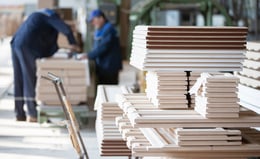5 Keys to Optimizing Furniture Logistics
Brian Hoey - November 20, 2018

Lots of businesses across disparate corners of the supply chain like to talk about their efforts to go lean, i.e. to drastically reduce their inventory usage by reducing lead times between production and shipping. This is often a logistical high wire act, requiring businesses to improve their production control, their demand forecasting, and their transport logistics. It’s also something that many furniture manufacturers have been doing since long before there was a trendy name for it. In fact, many modern furniture manufacturers rely on workflows that skip the inventory stage altogether, with products going straight from their respective production lines to the delivery vehicles that will bring them to their ultimate destinations.
As a result of this uniquely lean supply chain architecture, furniture logistics can present some of the thorniest problems faced in modern transport planning. How do planners construct efficient routes when there’s no warehouse that can reliably stock trucks with the necessary materials? How do you integrate complex customer delivery requirements into existing production and transport flows? Hopefully, we’ll be able to answer these questions and others with the following tips for optimizing furniture logistics.
1. Align Production and Transport Capacities
Because there is often no intermediate step between production and shipping in the furniture industry, misalignment between transport and production workflows can have wide-ranging consequences. If, for instance, you have a series of orders that need to be fulfilled in one geographic area, but the required products are not being sent through the production stream at the same time, you might end up having to make two trips to the same area when only one should have sufficed. Naturally, this will cost extra time and money while slowing down other deliveries. In order to avoid this, businesses need end-to-end (E2E) visibility into both their transport and production flows, so that production timelines can be adjusted to reflect shipping realities and vice versa. By putting these two processes into conversation, planners can create alignment in such a way as to avoid redundant shipping routes and work toward more efficient transport logistics.
2. Integrate Assembly Planning
Another of the unique challenges that face furniture manufacturers in the modern supply chain is managing an uncommonly varied set of customer expectations: specifically, businesses often have to provide assembly or installation services for the goods that are being delivered. This can be hugely disruptive to shipping routes and tours, requiring delivery persons to find longer term parking and pause in their deliveries to undertake a task that can vary widely in length and complexity. Because these particular types of customer requirement can be so disruptive, it’s crucial that planners integrate them into larger transport and production plans. A transport plan that doesn’t account for variances in assembly time is likely to be disrupted almost immediately, causing late deliveries and inefficient transport logistics. By making sure that each order you create includes assembly requirements and time estimates based on product type and building information, you can create more accurate timetables for your daily and weekly transport processes. In this way, you can reduce the number of late deliveries and smooth out your transport operations.
3. Simulate Routes and Tours
This one may seem a little bit obvious once you read it, but it bears saying nonetheless. In order to optimize your furniture logistics, you need to be able to optimize your route and tour structures. After all, no matter how sophisticated your IT integration is, you can’t maximize your value if you aren’t using the most efficient and cost-effective routes when you’re actually moving your products. Optimal route and tour planning can be a complicated process, but one of the most effective strategies that businesses can utilize is to simulate possible routing options to determine the most efficient option (either in terms of cost, time, or distance, depending your operational priorities). Once these possible routes have been generated and evaluated based on your criteria, they can be grouped into tours and put into practice. Doing so may require a high degree of visibility (your planners will need access to live traffic and weather information as well as all relevant order data), but the end result will be routes and tours that are not only more efficient, but more legible and controlled, meaning that they’ll fit more easily into your overall value chain planning.
4. Master Customer Notifications
This is another one that might go without saying, but we think it’s important to mention because it helps put some of the focus of optimization on your actual customers. It’s something of an industry stereotype that furniture delivery estimates can be fairly wide and sometimes inaccurate—and while you’ll be able to mitigate this with a more optimized overall process, it’s also important to remember that your relative success or failure is ultimately determined by the customer’s perception. This raises a few important questions: what system do you have in place now to alert customers that a delivery is in progress? How do you update your customers as your delivery estimates change? Can customers reach you reliably with changes in their own availability or status? By ensuring that you have an answer to these questions, you help to ensure that you’re providing your customers with a positive experience that inspires repeat business, even in the face of disruptions! If, for instance, you know that a particular shipment is going to be delayed, you can still provide value for your customer by telling him or her about the lateness (and providing a new estimated time) in the most timely possible fashion.
5. Expect Disruptions
Last but not least: the key to keeping your furniture logistics processes running smoothly, is to know that they’re often not going to run smoothly. Freak accidents cause tremendous highway delays. Flash flooding makes roads impassible. Production plant malfunctions lead to stock shortages. There’s simply no escaping it. The question, then, is what plans do you put in place to make sure that when a disruption comes along your value chain is able to adapt in an effective, value-saving manner? As it happens, almost all of the key strategies we outlined above will also figure prominently in your disruption responses. When running tour simulations, for instance, you can simulate potential disruptions in order to create 'Plan B's that can be implemented as needed. By the same token, if you have high visibility into your production workflows, you can more easily make adjustments to both production and transport processes as unexpected events like truck breakdowns and parts shortages arise. In this way, you can meet the furniture industry’s unique challenges head on, maintaining high degrees of leanness and agility in the process.
If you want to learn more get your Guide to Industry 4.0:
LATEST POSTS
- Understand Circular Economy in The Manufacturing Industry
- How Can Industry 4.0 IT Integration Be Achieved Smoothly?
- The Significance of Order Sequencing in Discrete Manufacturing
- How to improve your Supply Chain Management: The Power of Control Towers
- Optimizing Human Resource Scheduling in Manufacturing: A Technological Approach



